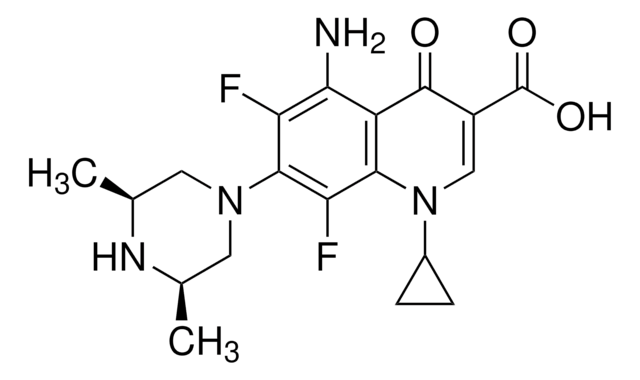The solution stability has not been tested. However, literature research suggests that enrofloxacin solutions dissolved in organic solvents such as methanol, ethanol, and dimethyl sulfoxide (DMSO) stored under frozen conditions can typically remain stable for approximately 26 to 52 weeks (6 to 12 months). The exact stability can depend on factors such as concentration, formulation, and specific storage conditions.
Wichtige Dokumente
17849
Enrofloxacin
≥99.0%
Synonym(e):
Baytril
About This Item
Empfohlene Produkte
Qualitätsniveau
Assay
≥99.0%
99.0-101.0% (dried substance)
Form
powder or crystals
Wirkungsspektrum von Antibiotika
Gram-negative bacteria
Gram-positive bacteria
Wirkungsweise
DNA synthesis | interferes
enzyme | inhibits
SMILES String
CCN1CCN(CC1)c2cc3N(C=C(C(O)=O)C(=O)c3cc2F)C4CC4
InChI
1S/C19H22FN3O3/c1-2-21-5-7-22(8-6-21)17-10-16-13(9-15(17)20)18(24)14(19(25)26)11-23(16)12-3-4-12/h9-12H,2-8H2,1H3,(H,25,26)
InChIKey
SPFYMRJSYKOXGV-UHFFFAOYSA-N
Suchen Sie nach ähnlichen Produkten? Aufrufen Leitfaden zum Produktvergleich
Allgemeine Beschreibung
Anwendung
- to investigate the pathological mechanisms resulting from the toxicity of fluoroquinolones in mammalian cells[1]
- to prepare a standard solution with 50% acetonitrile in a study to analyze illegal fish drugs used in aquaculture by employing surface-enhanced Raman spectroscopy (SERS)[2]
- as an analyte in a chemiluminescence reagent system[4]
Signalwort
Danger
H-Sätze
Gefahreneinstufungen
Acute Tox. 4 Oral - Resp. Sens. 1 - Skin Sens. 1
Lagerklassenschlüssel
11 - Combustible Solids
WGK
WGK 3
Persönliche Schutzausrüstung
Eyeshields, Gloves, type N95 (US)
Hier finden Sie alle aktuellen Versionen:
Analysenzertifikate (COA)
Die passende Version wird nicht angezeigt?
Wenn Sie eine bestimmte Version benötigen, können Sie anhand der Lot- oder Chargennummer nach einem spezifischen Zertifikat suchen.
Besitzen Sie dieses Produkt bereits?
In der Dokumentenbibliothek finden Sie die Dokumentation zu den Produkten, die Sie kürzlich erworben haben.
Kunden haben sich ebenfalls angesehen
-
Is it possible to store the drug frozen for long-term preservation after dissolving it in organic solvents?
1 answer-
Helpful?
-
-
What is the solubility of Antibiotic Question 17849 in water? This is intended for use in a mouse experiment involving drinking water.
1 answer-
The substance is not soluble in water. It has a solubility of 1mg/ml in organic solvents such as DMSO and 10 mg/ml in DMF. Additionally, it is suggested to try if the drug dissolves in (2-Hydroxypropyl)-β-cyclodextrin solution H5784.
Helpful?
-
Active Filters
Unser Team von Wissenschaftlern verfügt über Erfahrung in allen Forschungsbereichen einschließlich Life Science, Materialwissenschaften, chemischer Synthese, Chromatographie, Analytik und vielen mehr..
Setzen Sie sich mit dem technischen Dienst in Verbindung.












